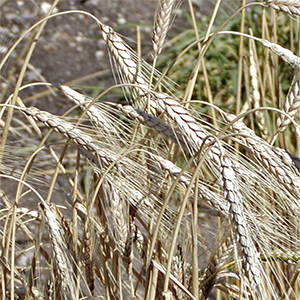Efficiency of index-based selection for potential yield in durum wheat [Triticum turgidum (L.) ssp. turgidum convar. durum (Desf.) Mackey] lines

HTML: 190
All claims expressed in this article are solely those of the authors and do not necessarily represent those of their affiliated organizations, or those of the publisher, the editors and the reviewers. Any product that may be evaluated in this article or claim that may be made by its manufacturer is not guaranteed or endorsed by the publisher.
Wheat is a socioeconomically important crop in Algeria. Improving genetic gain of quantitative traits through selection is at the core of every successful breeding program. Selection is usually performed on grain yield, but other agronomically related characteristics can also help increase genetic gain through indirect or multi-trait selection. The objective of this work was to quantify genetic parameters and compare the efficiency of direct, indirect and simultaneous selection methods in terms of predicted genetic values of wheat progenies. For this purpose, 418 F4-derived lines were evaluated for six agronomic traits including heading date, flag leaf area, plant height, number of spikes, thousand kernel weight and grain yield in an augmented block design with three check varieties. Wide genetic variation with moderately high broad-sense heritability were observed for the recorded traits, except for heading date. The results from genetic gain revealed variation in gains for assessed traits and breeding methods employed. The classic index of Smith and Hazel (SHI) demonstrated a similar genetic gain in grain yield compared to gain from direct selection. Generally, the selection-based index showed the highest responses considering all traits simultaneously with a slight inferiority of the SHI index. The coincidence rates among the evaluated indices were higher than those obtained between the measured traits. Based on the comparisons between the selected lines, the SHI index and the selection base index of Williams were similar to grain yield and can reach up to 79.51% coincidence of breeding lines identified by these selection criteria. Breeding lines L252, L34, L24, L130 and L413 were the most common individuals identified according to number of coincidences from the different selection methods used. Of these, L34 and L24, and to a lesser extent L15 can be considered promising wheat lines for improving grain yield.
How to Cite

This work is licensed under a Creative Commons Attribution-NonCommercial 4.0 International License.
PAGEPress has chosen to apply the Creative Commons Attribution NonCommercial 4.0 International License (CC BY-NC 4.0) to all manuscripts to be published.

 https://doi.org/10.4081/ija.2023.2182
https://doi.org/10.4081/ija.2023.2182



